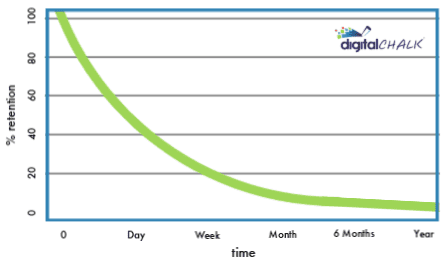You’ve heard the frightening training stats.
60% of training is forgotten 20 minutes after it’s taught.
… and by 3 days the AMOUNT FORGOTTEN increases to 75%!
Think about that. It’s the equivalent of saying that for every hour of instruction, 45 minutes is wasted.

Any sensible person seeing these stats may wonder why bother with training in the first place? After all, these numbers are enough to make the learning and development team’s blood run cold. But, the companies that use these statistics — are actually abusing them.
What Is the Ebbinghaus Forgetting Curve?
The history behind those scary (and overblown) learning statistics dates back more than 100 years to the work of a German psychologist, Hermann Ebbinghaus. Ebbinghaus was curious to learn how the brain forms and retains memories.
After a series of experiments, he discovered the brain lets go of information at a reliable rate, which he termed “The Forgetting Curve.” His findings can be summarized in the following statistics:
- After 20 minutes, the human brain can only recall 60% of the information.
- After 24 hours, 70% of the information has been forgotten.
- After a month, less than 25% of the information can be recalled.

And for the last 100 years, people have been abusing the Ebbinghaus Forgetting Curve by stopping there and pulling morsels of data to disparage learning and development – and make it seem as though the human brain isn’t capable of holding on to much.
But that’s not where Ebbinghaus’s research ended…
Ebbinghaus found that memories degrade fairly quickly. But his research went further, delving into why some memories just stick.
First, he tested exposing learners to information over and over in a short window of time. As you can probably guess if you have crammed for a test, Ebbinghaus found short-term, quickly degrading benefits, but no positive effect on long-term retention.
However, when he presented learners with information repeatedly over intervals of time that got progressively longer, the Forgetting Curve was flattened and long-term memories were produced. He termed this successful approach spaced repetition. But in the learning and development field, we call it reinforcement.
Practice Makes Perfect?
While stats pulled from the Ebbinghaus Forgetting Curve are arguably the most abused stats in the learning and development industry, practice makes perfect may be the most abused phrase. It tells only half the story.
Feedback is essential for successful training and reinforcement. The last thing you want is an employee who has completed training but still doesn’t understand the material. That’s why the DigitalChalk LMS allows Admins to insert pop-up questions, called Checkpoints, throughout the course content for instant feedback. We also recommend incorporating assignments and tests into coursework, and rewarding learners with custom badges, kudos, and certificates.
Without feedback, your team could not only fail to understand the information covered during workplace training – but they could also develop bad habits.
Imagine you spend all winter practicing your golf swing at an indoor driving range. No golf pro at your side. Just you and a bucket of balls. While the snow falls, you are faithfully whacking those balls down the range as hard as you can. And you don’t just practice once. You practice repetitively over time.
The thaw comes and you hit the links, only to discover that your swing is worse than it was in the fall. And all that practice did was reinforce your bad swing, which is now a tougher habit to break.
Yes, you practiced. But, you lacked coaching and feedback. So you certainly didn’t make perfect.
If your employees don’t get the feedback they need during training and reinforcement, they will not only continue making the same mistakes — they will be reinforcing bad habits, which will make them harder to break.
What to look for when investing in an LMS
When you make an investment in an enterprise-level learning management system, look for one that not only features real-time feedback, testing, and creative ways to reward learners for a job well done but offers training simulations like UPtick. Simulations not only help to reinforce learnings, but they also help ensure your staff is reinforcing skills correctly and in a risk-free environment.
